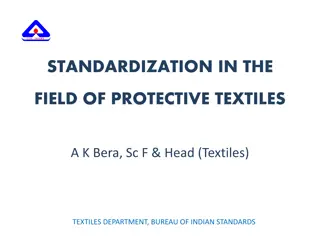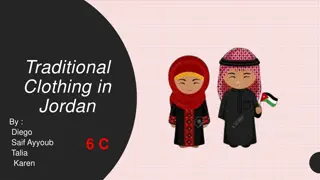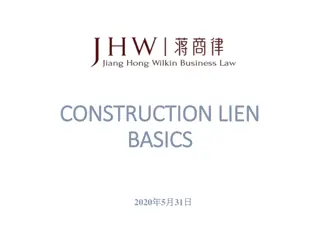Clothing Construction Standards - Pockets Unit Overview
This article delves into the history, importance, and purpose of pockets in western clothing, focusing on the definition of pockets, the evolution of inseam pockets, and their significance in garment construction standards.
Download Presentation

Please find below an Image/Link to download the presentation.
The content on the website is provided AS IS for your information and personal use only. It may not be sold, licensed, or shared on other websites without obtaining consent from the author.If you encounter any issues during the download, it is possible that the publisher has removed the file from their server.
You are allowed to download the files provided on this website for personal or commercial use, subject to the condition that they are used lawfully. All files are the property of their respective owners.
The content on the website is provided AS IS for your information and personal use only. It may not be sold, licensed, or shared on other websites without obtaining consent from the author.
E N D
Presentation Transcript
Hindusthan College of Arts & Science An Autonomous College-Affiliated to Bharathiar University Approved by AICTE and Govt. of Tamilnadu Accredited by NAAC-An ISO Certified Institution TOPIC: Clothing Construction Standards - pockets Unit - i SUBJECT : STANDARDS AND SPECIFICATIONS FOR CLOTHING(20CDP02) Class : I M.SC CDF
Definition of Pocket A pocket is a small bag, particularly a bag-like receptacle either fastened to or inserted in an article of clothing. There was a sack called a pocket which was used particularly for storing
History of Pockets Pockets first began appearing on waistcoats and trousers about 500 years ago. As you probably already know, about half the population wasn't wearing trousers back then. For women in the 1600s and beyond, pockets were a separate garment that tied on between a skirt and petticoat
Importance of Pockets Pockets are a small but important component of western clothing. Despite their deceptive obscurity and utilitarian nature, pockets are sensitive to fashion changes and they can reveal a wealth of social and cultural information
Purposeof Pockets Pockets and purses are often presented as opposites, yet both function as places to carry and store valuables
INSEAM POCKETS INSEAM POCKETS
INSEAM POCKET Definition- Inseam pockets occur at a structural seam on the garment, most commonly at a side seam of skirts and slacks, but may be placed in other seams as well. Introduction Inseam pockets are the type of pockets that are hidden in a seam of your garment and are entirely enclosed by the outer layers, leaving no visible edges, stitching lines etc. They are primarily, though not exclusively, used on dresses, skirts and some pants
INSEAM POCKET Appearance - not visible unless decorative; flat, does not gap. Reinforced - to prevent stretching and pulling
1. Functional pockets are positioned at a location convenient for use. 2. Openings on functional pockets are large enough for the intended use. 3. The pocket depth is correct for the location. Pocket sacks do not extend past the hem or facing of the garment. 4. Openings that are angular or on the bias have been reinforced to prevent stretching. 5. Pocket openings are reinforced at the beginning and end. 6. Seams lie flat without pulling or puckering, and the raw edges have been finished as the garment's quality, fabric and location demand.
7. Lining fabric, if used for the pocket bag, is durable, appropriate, and has the same care requirements as the garment's fabric. 8. The body of the pocket is anchored when possible to maintain its position and to prevent sagging. 9. The edges of the pocket opening appear the same size, with no puckering or pulling on either side. 10.The pocket lining is recessed enough so it does not show during movement and while sitting. 11.The pocket is cut on appropriate grain, generally duplicating the garment's grain line.
Applied POCKETS Applied POCKETS
Applied POCKETS Applied POCKETS Definition - Applied pockets, often referred to as patch pockets, and are usually made from the fashion fabric cut in any desired shape or size. Introduction As the name indicates, applied pockets are sewn onto the garment usually with top stitching. Mainly patch pockets are attached to the outside/on the surface of the garment. Patch pocket consists of variously shaped fabric sections applied to the right side of the garment
Applied POCKETS Applied POCKETS Appearance - flat, uniform, fabric around pocket not stretched Bulk - seams graded, corners trimmed, curves clipped and/or wedged Width - even Corners - perfectly formed, free from pulling or drawing Facing - securely stitched, finished; as little bulk as possible Stitching - secure, even inconspicuous
Applied POCKETS Applied POCKETS 1. Functional applied pockets are positioned at a location convenient for use. 2. Openings on functional pockets are large enough for the intended use. 3. The pocket depth is correct for the location and is in proportion to the design. 4. Interfacing is used when needed to hold the pocket shape. 5. Pockets are cut on the appropriate grain, and any fabric designs are matched. If a bias cut is used, pockets are not stretched and are properly stabilized and paired. 6. Comers match, with no raw edges or lining fabric visible. 7. Enclosed seams are trimmed, usually to one-fourth inch (.64 cm) or less. 8. Curves, if present, are smooth and the sides are symmetrical unless otherwise designed.
Applied POCKETS Applied POCKETS 9. Pockets and/or flaps lie flat without pulling, twisting, sagging, or rolling. 10.Paired pockets appear the same height, the same size, the same shape, and at the same location on the garment. 11.Linings do not roll to the right side at the edges of the pocket, but remain out of sight. 12.If used, topstitching is an equal distance from the edge at all points unless otherwise designed. An appropriate stitch length has been used, and all loose thread ends have been secured and hidden. 13.Trims or decorations are neatly applied and appropriate for the design and location. 14.Pocket corners are reinforced properly according to type, location, method of application, fabric, and use. 15.Facings or hems are deep enough to stay in position; raw edges are appropriately finished for the fabric and location; under stitching is present when needed, and seams are appropriately trimmed.
Slashed POCKETS Slashed POCKETS
SLASHed SLASHed POCKETS POCKETS Definition - Slashed pockets, or welt pockets as they are sometimes called, have one or two strips of fashion fabric applied to the right side of the garment to conceal the raw edges of the pocket opening. Flaps may accompany the welts, and a lining must be applied and turned to the wrong side to complete the body or bag of the pocket and to conceal the small welt seams. Introduction : Also known as 'slant' pockets, slash pockets commonly appear on pants, slacks, and jackets. These pockets are set into the garment on an angle, allowing the wearer to slide their hands in and out easily. On pants, slash pockets will typically start at the waistband and slash down toward the outseam
SLASHed SLASHed POCKETS POCKETS 1. Functional pockets are positioned at a location convenient for their use. 2. Openings on functional pockets are large enough for the intended use. 3. The pocket depth is appropriate for the location. Linings do not extend below the hem fold in jackets. 4. Openings, flaps, and welts are interfaced when necessary for body and shape retention. 5. Pockets are cut on the appropriate grain with the fabric design matched, if applicable. Bias welts and flaps are properly stabilized and not stretched during their application.
SLASHed SLASHed POCKETS POCKETS 6. Enclosed seams are trimmed, usually to one-fourth inch (.64 cm.) or less. 7. There are no holes, pleats, or puckers at the ends of the slashed openings. The ends are angled identically on both sides of garment as indicated by the design. 8. Flaps, when present, are of sufficient length to cover the welts and lie flat. 9. The pocket facing is fashion fabric applied to the pocket lining, directly beneath the pocket opening, when buttonhole or narrow single welts are used, to prevent the lining from showing when the pocket is being used. 10.Fabric triangles formed at the ends of the slashed openings are secured with several rows of small stitches or with bartacks.
SLASHed SLASHed POCKETS POCKETS 11.Lining fabrics are appropriate for the location and for the fashion fabric weight, care requirements, and use. 12.Raw edges of the lining are appropriately finished as required for the pocket location. 13.Paired pockets appear identical in length, width at openings, and the distance from the garment edge. 14.Pockets lie flat without pulling, twisting, or rolling.
SLASHed SLASHed POCKETS POCKETS Appearance - decorative, attractive, flat, smooth Bulk - seams graded, comers trimmed, curves clipped and/or wedged Hem - in proportion to pocket shape and size Placement - pairs are balanced and uniform or coordinated in size and shape Reinforced - upper comers stitched to reinforce Stitching - even, suitable to fabric and garment design
POCKET STANDARDS POCKET STANDARDS Ensure pocket flaps are securely attached. Completely conceal all drill holes and chalk marks used for positioning pockets and flaps. Do not allow puckering to occur when attaching patch pockets. The fabric used in pocket bags must be of relevant weight and strength. Refer to Standard Fabric Performance Requirements for Apparel Revised Specification for more information. Minimum openings for sideseam pockets are: children 10 cm adults 15 cm. Ends of sideseam pockets must be caught into seams or reinforced at the top and bottom. Pocket facings must not roll out or show the lining. Pocket jet welts must not gape or be stretched when finished. Pockets are symmetrical. Pockets must match left and right side
THANK YOU THANK YOU























